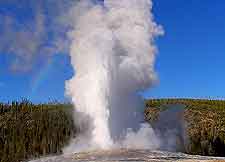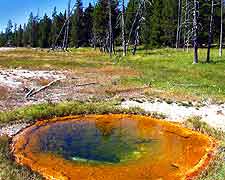West Yellowstone History Facts and Timeline
(West Yellowstone, Montana - MT, USA)

This rustic southern Montana town lies near the
Wyoming state line and grew up alongside the Yellowstone National Park and its western gateway. Tourists would visit the park and the Old Faithful geyser by stagecoach and stay in the town at the Madison Hotel.
Home to an airport and the original rail depot where tourists would arrive, the town, historically, retains many reminders of the early days of West Yellowstone history.
West End
Before West Yellowstone was a town, it was simply known as Riverside, Boundary or West End, referring to Yellowstone Park's western entrance. The town was officially one of the entrances to the park in 1907 (when it was first settled), although it didn't get the title of West Yellowstone until 1920.
Tourists arrived a year later by train along the Oregon Short Line extension, which is the main reason why the town came about. A post office opened in 1908 under Charles Arnett, along with the Yellowstone Store, which became Eagle's Store two years later - the latter still stands today on Yellowstone Street.
Union Pacific Depot
The Union Pacific Depot was founded in 1908, adding to West Yellowstone history and bringing in the first tourists, who would head into the park via stagecoach. The Yellowstone Historic Center Museum is housed in the original depot. The stagecoach, as a means of visiting the park, didn't last long when the automobile came on the scene, although buses were used to take tourists into the park and an original bus can be seen in the museum.
Built in 1912, the wooden Madison Hotel was the place to stay, complete with in-room wash basins and flues from the downstairs fireplace for warmth. The hotel is still standing today. Tourist arrivals ramped up considerably in the 1920s, so much so that the Union Pacific Railroad built a huge dining hall in 1925, complete with high ceilings. Today, it is known as the UP Dining Hall and still holds big events. After WWII, rail arrivals dropped off and by 1960, they stopped altogether.

Winter Access
West Yellowstone was closed in the winter due to heavy snow on the roads and rail lines, and any residents that stayed on were snowed in, relying on dogsleds for supplies and transport. After the Bozeman Road was completed in 1936, it became possible to drive in from Montana year-round, as the route was ploughed. A year prior to the completion of the road saw the opening of the Old Airport (still in use today), where snow planes were used for winter tours. In the 1960s, you could actually tour the park on snowmobiles and snow coaches, and can still visit it today from December to March.
Yellowstone Historic Center Museum
Despite the tourism and injection of relative wealth into West Yellowstone, its streets weren't actually paved until the 1980s, which is when it also got a proper sewer system. The town still relies wholly on tourism and many of its residents are descendants of the early settlers.
See the Yellowstone Historic Center Museum in the former Union Pacific Railroad Depot for more information on the history of West Yellowstone and the park, and visit the Playmill Theater on Madison Avenue, which hails from the mid-1900s, for evening entertainment if staying overnight.
 This rustic southern Montana town lies near the Wyoming state line and grew up alongside the Yellowstone National Park and its western gateway. Tourists would visit the park and the Old Faithful geyser by stagecoach and stay in the town at the Madison Hotel.
This rustic southern Montana town lies near the Wyoming state line and grew up alongside the Yellowstone National Park and its western gateway. Tourists would visit the park and the Old Faithful geyser by stagecoach and stay in the town at the Madison Hotel.